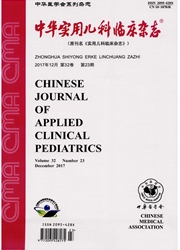

 中文摘要:
中文摘要:
目的探讨急性白血病(AL)患儿柔红霉素(DNR)化疗致心肌损害时血清硫化氢(H2S)水平变化。方法2008年10月一2011年6月小院儿童血液科住院的AL患儿共159例,中位年龄7岁。均行含DNR方案化疗,采用敏感硫电极法测定其化疗前后血清H2S水平变化,分析在不同DNR累积剂量时心肌细胞损害与H2S的关系。结果随着DNR累积剂量的增加,心肌损害的发生牢亦随之增高(P。〈0.05),血清H2S水平亦随之增加。中剂量组患儿血清H2S水平较低剂量组升高,差异有统计学意义(P〈0.05);而高剂量组血清H2S水平较中剂量组进一步升高,差异有统计学意义(P〈0.01)。心肌损害组血清H2S水平较无心肌损害组显著升高,差异有统计学意义(P〈0.01)。对心肌损害组和无心肌损害组血清H2S水平进行ROC曲线分析,ROC曲线下面积为0.929(95%C10.8571.000)。以假阳性率(1一特异性)2.8%为诊断点,血清H2S诊断心肌损害的诊断点为128.09Ixmol·L-1,以此诊断的敏感性为83.3%,特异性为97.2%。对心肌损害患儿进行回顾性分析发现,DNR剂量达中剂量以上心肌细胞尚未受损时,其血清/H2S水平已显著升高。以128.09Ixmol·L-1为临界点,血清H2S水平升高的患儿其进一步化疗心肌损害的发生率亦显著升高。结论血清H2S水平可反映心肌细胞的损害程度,是早期监测心肌细胞受损的有效指标。
 英文摘要:
英文摘要:
Objective To investigate the changes of serum hydrogen sulfide (H2S) in acute leukemia (AL) children with daunorubicin (DNR) - induced myocardial damage. Methods From Oct. 2008 to Jun. 2011 , one hundred and fifty - nine cases of AL children were en- rolled in this study at Beijing Shijitan Hospital. The median age was 7 years. All these children received DNR - containing regimen chemothe- rapy. Serum levels of H2 S were measured before and after chemotherapy, and the correlation between different cumulative doses of DNR and H: S levels were analyzed. Results As the cumulative dose of DNR increased, the incidence of myocardial damage increased ( P 〈 0.05 ) , and the serum levels of H2S also increased. Levels of H2S of middle - dose children increased significantly than those in the low - dose (P 〈 0.05 ) ; and levels of H2 S in high - dose group increased further than those in middle - dose group (P 〈 0.01 ). Levels of H2 S in children with myocardial damage increased obviously than those without myocardial damage, and the difference was significant (P 〈 0.01 ). Furlbm'more, ROC analysis showed the area under ROC crave was 0. 929 (95% C10. 857 - 1. 000) , take false positive rate ( 1 - specificity)2.8% as the diagnosis of point,the optimum cut - off value of H2S was 128.09 Ixmol . L-1 , and the sensitivity and specificity were 83.3% and 97.2%, respectively. Retrospective analysis showed that the AL children with myocardial damage and those with over middle - dose DNR chemothera- py but without myocardial damage had higher levels of H2S. Taking as the optimum cut - off value, the higher the H2S level was, the higher mortality of myocardial damage would be. Conclusion Serum levels of H2 S in children with AL can reflect the extent of myocardial damage, and it would be an effective indicator for early detection of myocardial cell damage.
 同期刊论文项目
同期刊论文项目
 同项目期刊论文
同项目期刊论文
 Sulfur dioxide preconditioning increases antioxidative capacity in rat with myocardial ischemia repe
Sulfur dioxide preconditioning increases antioxidative capacity in rat with myocardial ischemia repe The ERK1/2 signaling pathway is involved in sulfur dioxide preconditioning-induced protection agains
The ERK1/2 signaling pathway is involved in sulfur dioxide preconditioning-induced protection agains Sulfur dioxide inhibits excessively activated endoplasmic reticulum stress in rats with myocardial i
Sulfur dioxide inhibits excessively activated endoplasmic reticulum stress in rats with myocardial i Sulfur dioxide derivatives improve the vasorelaxation in the spontaneously hypertensive rat by enhan
Sulfur dioxide derivatives improve the vasorelaxation in the spontaneously hypertensive rat by enhan 期刊信息
期刊信息
